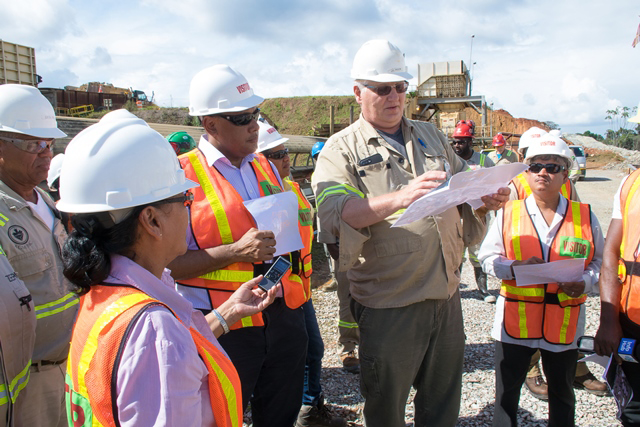Guyana Goldfields Inc is currently building a new 2,000-metre airstrip at the Aurora Gold Mine (AGM) on the Cuyuni River to replace the one in use as the dike of the mining pit is being extended to include a section of the current runway.
The extension of the dike is to guard against “a thousand-year (flood) event” says AGM General Manager, Operations Vic Rozon. He was speaking on Wednesday during a tour of the operations by Minister of Natural Resources, Raphael Trotman and Minister in the Ministry of Finance, Jaipaul Sharma.
Technical officer in the Ministry of Natural Resources Euliene Watson said that Omai Gold Mines Limited had given assurances but the toxic cyanide spill that entered the Essequibo River when the banks of the tailings pond broke in 1995 was destructive.
“We may not be talking cyanide as happened with Omai but a failure in the dike in the rainy season,” she said, is a matter of concern.
The extension of the dike, he said, will not affect the revetment to the river nor will the river be diverted.
Rozon also answered questions from Trotman and Sharma after they were given a tour on Wednesday, of the mining pit which is about a mile deep and going deeper as the operations transition to the underground.
Noting that the Cuyuni River is one of the most polluted rivers in Guyana affected by mining, Trotman said, “We would not want it to be affected in any other way.”
In October last year, Rozon said, it was a rare occasion when the river rose and part of the airstrip was flooded. Apart from heavy rains, the river rises when water is released from the Guri Dam in Venezuela.
“We have drilled to see if there is any infiltration from the river and based on geotechnical drilling that was done,” he said, “the water coming from the ground is not coming from the river but is mainly underground runoffs.”
The pit, he noted, is deeper than the depth of the river. “During the dry season you can walk across.” The land for the dike has no other river close by.
Even the cyanide used in the processing of the gold is being neutralized, he said.
Administrative manager of the Canadian mining operation, Peter Benny said he and Rozon were at Omai when the spill occurred. “We want to ensure that something like that never happens here again.”
One of the mistakes made at Omai, he said, was that they did not put the tailings close to the dam so there was too much water pressure on the dam. “One of the first things that we did when we started this place up was to put all of the tailings at the dam so there is no water pressure there. The tailings pond is a wide open area and far away from the river.”
Noting that the mine’s operations has a 16-year life span, Sharma asked if sources of fuel, other than diesel, were being contemplated.
Rozon said that studies done on hydropower would not be sufficient but Guyana Goldfields is to do a solar energy pilot at its Buck Hall facility in the north west. Once successful, the aim is to do the same at the Aurora camp.
Sharma suggested that a blend of solar, hydro and diesel would leave a lower carbon footprint.
Asked about its mining standards, Rozon said, operations of this type according to international mining standards are about 91 percent. “We are currently operating at about 93 to 94 percent.”
In terms of the technology and from a mining perspective, he said, the ore body is not toxic and it has no issues with sulphides or arsenic. “It is very clean and one of the best ore bodies in the world.”
The standards at AGM, he said, are equal to any quality standards in the world including Canadian, American and world regulatory standards. Living accommodations, health and safety standards and the way they recruit staff, he said, are to international standards.
About the road from Buck Hall to the mining camp which Guyana Goldfields now spends over US$100,000 a month to maintain, Trotman said, his ministry and the Ministry of Public Infrastructure are working out an arrangement for them to officially maintain it.
In brief remarks, Trotman said, Government was impressed with AGM’s efforts, their work ethic, safety record, mine construction, local content and the ease with which they carry out their operations.
Noting that last year they produced over 160,000 ounces of gold, he said, “Government expects you not only to make the 200,000 this year but to surpass it.”






